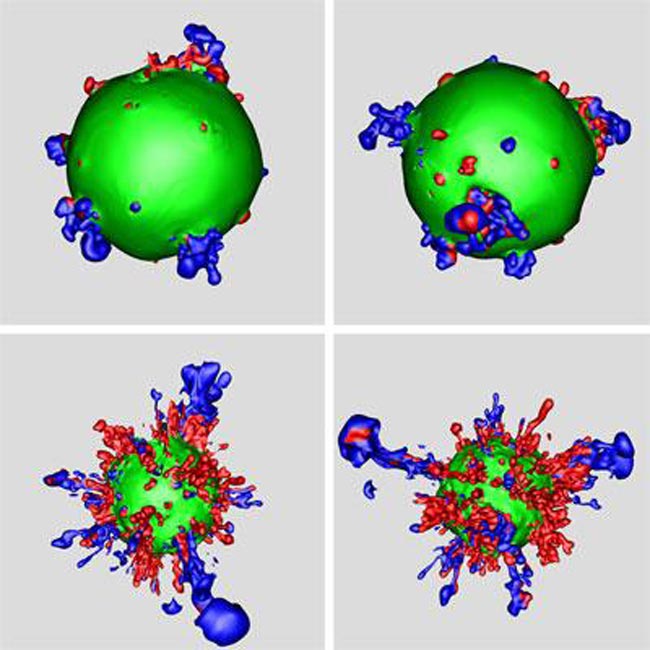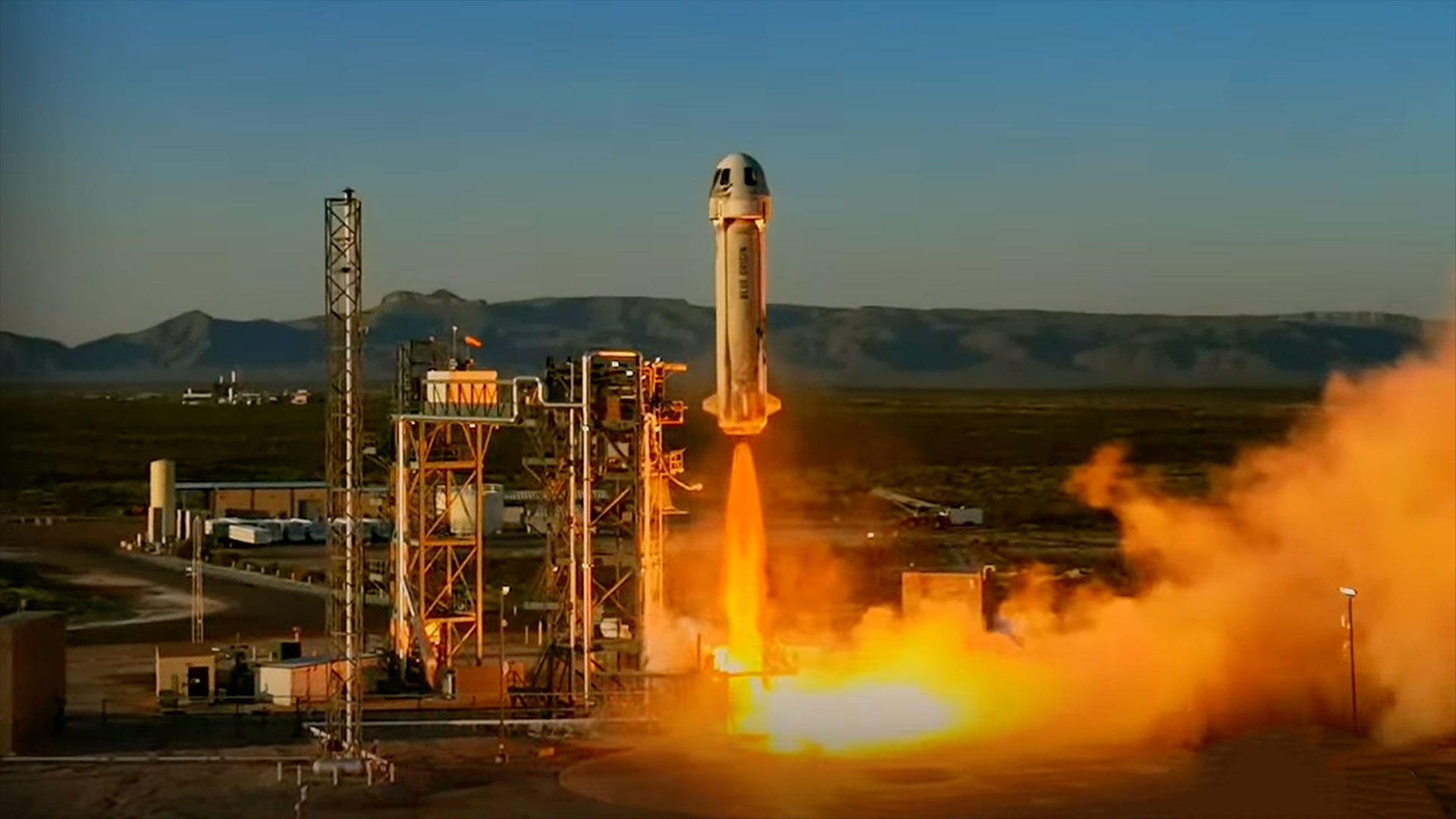Supernova Explosion Recreated in 3-D

The physical processes behind the spectacular supernova explosions from dying stars are so complex that astrophysicists have only been able to simulate parts of the process, and only in one or two dimensions. That is, until now.
Researchers at the Max Planck Institute for Astrophysics in Garching, Germany have carried out the first fully 3-D view of a supernova that shows the internal collapse and violent explosion, recreating the event over a timescale of hours following the initial cosmic blast.
When a massive star dies, it triggers a gigantic explosion called a supernova that can briefly shine brighter than an entire galaxy. The new 3-D computer model recreated the well-known supernova SN 1987A.
The star called SN 1987A, located in the Tarantula Nebula in the Large Magellanic Cloud, a neighboring galaxy, collapsed in a supernova explosion in 1987 that was so bright it could be seen even with the naked eye.
By recreating the blast in 3-D, astronomers have found that older two-dimensional simulations of SN 1987 ? which assumed some symmetry in the star's spherical shell as it exploded ? turned out to be incomplete.
"We found substantial deviations in our 3-D models compared to previous work in 2-D, especially the growth of instabilities and the propagation of clumps differ," said Nicolay Hammer, the lead author of the paper, in a statement. "These are not just minor variations, this effect determines the long-time evolution and ultimately the extent of mixing and observable appearance of core-collapse supernovae."
These new computer models can help astrophysicists better understand the stages of supernova explosions, and can provide valuable details on how supernovae obtain their size.
Breaking space news, the latest updates on rocket launches, skywatching events and more!
The study was published in the May 10 issue of the Astrophysical Journal.
Tricky details of dying stars
The details of supernova explosions have been difficult to simulate, because the physical processes that take place are extremely complex, and also because the duration and range of scales ? from hundreds of feet near the center to tens of millions of miles near the stellar surface ? require sophisticated computer models.
Older one- and two-dimensional simulations provided helpful tools for understanding parts of the supernova process, but the real world exists in 3-D, and these older models were unable to incorporate all observational aspects of the blast.
But, the new 3-D computer models, developed by researchers at the Max Planck Institute, can now simulate the complete burst in all three dimensions, from the first milliseconds after the explosion is triggered in the core, to a time three hours later.
One unexpected discovery was how nickel, iron and other heavy metal-rich elements mixed with hydrogen and moved outward as they erupted from the center of SN 1987A when it exploded.
Scientists observed that nickel bullets were propagated at velocities of thousands of miles per second, much faster than the surrounding hydrogen, and much faster than what was predicted by simple hydrodynamic calculations from one-dimensional models. One-dimensional models only studied the radial profile of the supernova from the center outwards.
In the 3-D simulations, metal-rich clumps or material were found to have much higher velocities than their 2-D counterparts. These "bullets" of material expand much more rapidly, overtaking material from the outer layers.
"With a simple analytic model we could demonstrate that the different geometry of the bullets, toroidal versus quasi-spherical, can explain the differences observed in our simulations," study co-author Thomas Janka explained. "While we think that the differences between the 2-D and 3-D models that we found are probably generic, many features will depend strongly on the structure of the progenitor star, the overall energy and the initial asymmetry of the blast."
While the immense energy from these stellar explosions make them visible far out into the universe, supernova bursts are relatively rare. On average, only one supernova will occur in 50 years in a galaxy comparable in size to our own Milky Way.
The thing about SN 1987A
SN 1987A turned out to be a core-collapse supernova, a so-called Type II event, which is a classification used to describe a massive star that undergoes an internal collapse and violent burst.
A Type II supernova occurs when a star, which is at least nine times heavier than the sun, burns almost all of its fuel. The fusion engine in the center of the star begins to stutter, which triggers an internal collapse, followed by a violent explosion of the entire star.
At its birth, SN 1987A had a mass that was roughly equivalent to 20 times the mass of the sun.
Since SN 1987A's collapse occurred in a galaxy that is relatively close by ? roughly 170,000 light-years away ? scientists were able to gather many detailed observations in different wavelength bands over the weeks and months that followed. Yet, while this supernova is one of the best studied stellar explosions, it has still been a challenge to develop and refine models of what was happening inside the dying star that produced its emission of radiation.
It turned out that the brightness evolution, or the so-called light curve, of SN 1987A and of other similar core-collapse supernovae can only be understood if large amounts of heavy core material ? particularly radioactive nickel ? are mixed outwards into the stellar envelope, and if light elements (such as hydrogen and helium from the envelope) are carried inwards to the core.
Future simulation work will investigate a wider variety of progenitor stars and will focus on initial conditions of supernova explosions.
"We hope that our models, in comparison to observations, will help us to understand how stellar explosions start and what causes them," said study co-author Ewald M?ller.

Denise Chow is a former Space.com staff writer who then worked as assistant managing editor at Live Science before moving to NBC News as a science reporter, where she focuses on general science and climate change. She spent two years with Space.com, writing about rocket launches and covering NASA's final three space shuttle missions, before joining the Live Science team in 2013. A Canadian transplant, Denise has a bachelor's degree from the University of Toronto, and a master's degree in journalism from New York University. At NBC News, Denise covers general science and climate change.
